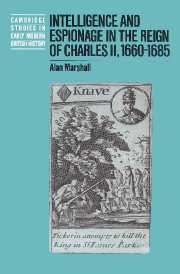Book contents
- Frontmatter
- Contents
- Acknowledgements
- List of abbreviations
- Introduction
- 1 The Restoration secretariat and intelligence, 1660–1685
- 2 Intelligence and the Post Office
- 3 Local intelligence networks in the north of England
- 4 ‘Taking the ruffian's wage’: spies, an overview
- 5 The spies of the early Restoration regime, 1660–1669
- 6 The spies of the later Restoration regime, 1667–1685
- 7 The foreign and diplomatic scene
- 8 Assassination: ‘an Italian trick, not used in England’
- Conclusion
- Bibliography
- Index
- Cambridge Studies in Early Modern British History
6 - The spies of the later Restoration regime, 1667–1685
Published online by Cambridge University Press: 29 September 2009
- Frontmatter
- Contents
- Acknowledgements
- List of abbreviations
- Introduction
- 1 The Restoration secretariat and intelligence, 1660–1685
- 2 Intelligence and the Post Office
- 3 Local intelligence networks in the north of England
- 4 ‘Taking the ruffian's wage’: spies, an overview
- 5 The spies of the early Restoration regime, 1660–1669
- 6 The spies of the later Restoration regime, 1667–1685
- 7 The foreign and diplomatic scene
- 8 Assassination: ‘an Italian trick, not used in England’
- Conclusion
- Bibliography
- Index
- Cambridge Studies in Early Modern British History
Summary
In the second half of the reign of Charles II the world of espionage and conspiracy continued to be as perplexing for the government as in the first half. The ‘problem’ of Catholicism also began to loom, to explode in the Popish Plot of 1678. There were a number of men employed as spies by the regime in this period and while it is not possible to trace all of their careers here, lengthy case studies are given of two of the most notable and complex individuals who enlisted as covert soldiers in the regime's espionage wars: Thomas Blood and John Scott.
Sir Joseph Williamson, who came to know Thomas Blood quite well, noted on the day after Blood's attempt on the Crown Jewels that it was ‘one of the strangest any story can tell’. There is no doubt that Thomas Blood was the nonpareil of the seventeenth-century spy, rebel and adventurer. There is no-one quite like Blood in the Restoration regime's service, or for that matter out of it. He was distinctive in many ways, but most of all his is the only fully rounded figure of a spy in the period we can uncover. The others involved in the Restoration regime's intelligence system remain at heart shadowy figures. With Blood, however, we have a man whose thoughts we can actually penetrate through his own personal writings. Yet in spite of this there are great mysteries both concerning the man and his career. Notorious in his day, he was also adept in covering his tracks.
- Type
- Chapter
- Information
- Intelligence and Espionage in the Reign of Charles II, 1660–1685 , pp. 186 - 243Publisher: Cambridge University PressPrint publication year: 1994



